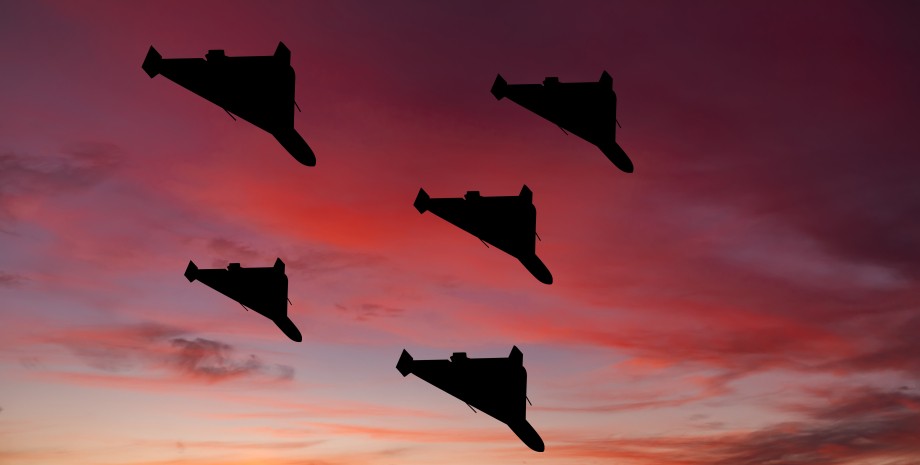
 By Natali Moss
By Natali Moss
Focus considered that such improvements would give the occupiers and how much they will increase the cost of production. The tactical group of the Armed Forces "Stalin Falcons" posted a video on Telegram, allegedly filmed by the chamber's drone with a built -in camera. The Russian Channel "Operation Z: Voenokori Russian Spring" suggested that now part of such UAVs will be controlled by operators to bypass the air defense systems in Ukraine.
First of all, the invaders threaten to attack mobile fire groups of the Armed Forces, which are beating "Shahda" by machine guns. At the end of September, Russian President Vladimir Putin during a visit to the Special Technological Center in St. Petersburg showed a number of unmanned local systems. During this event, the cameras of the operators also recorded a black drone that resembles Shahd-136, but with a changed nasal part.
The same design has a shock drone Shahd-236 Iranian production, which is attributed to the availability of an electronic-optic system for autonomous search for targets or manual manual manual. At the beginning of 2024, "Militar" analyzed documents stolen by Prana Network hackers from the servers of Iranian company IRGC Sahara Thunder, they were dedicated to the transfer of unmanned technologies from Iran to Russia.
Judging by the files, the Russians were going to establish the production of "Shahaned" with a system of capture of goals that were cipher "MS-236". In one of the Russian presentations, the authors provided the use of such UAVs together with a drone-retraislator of the same design and control station. The range of the complex was estimated at 220 kilometers. The records also mentioned the estimated cost of the drone (probably for sale to the Russian Federation), which amounted to about $ 900,000.
This price is obviously inflated several times, given that in 2022 Shahd-136 Iran sold Russia for $ 193 thousand. The price is probably included in the cost of the new "stuffing" and the license and the cost of localization of production. This is a lot, 4. 6 times more than the original ShahED-136, so it is unlikely that the Armed Forces of the Russian Federation will be able to get new remedies in the same amount.
Igor Krynychko, the chairman of the Skyssist Skyssist Supervisory Board, which produces in Ukraine intelligence unmanned complexes "Sirko", says that the installation of the course chamber does not significantly increase the cost of production. Judging from the video, it is quite poor and costs only $ 50-100. Another issue is a manual communication system. Original Iranian ShahED-136 fly offline, giving the target thanks to the GPS satellite system.
Where the signals from the satellites do not pass, the drones are driven by the inertial navigation system - a set of sensors and gyroscopes that allow to follow a programmed mission approximately. The inertial system is quite inaccurate, so or further, the more "Shahaned" deviates, but UAV immediately adjusts the route when GPS work is restored. Today, a significant number of "Shahaned" is being knocked down by Ukraine due to the system of HR, known as "Intercession".
It is able to block satellite navigation signals or replace them so that the drone was not flying to where the invaders were sent. In this regard, the Russians are experimenting with the connection so that drones can be tracked in the air and control them as needed. Thus, the Ukrainian military was found among Shahhedi's wreckage and LTE modems with SIM cards for cellular communication, and recently-Starlink terminal for satellite.
It is likely that this will allow Russian operators manually to control drones at a considerable distance, possibly hundreds of kilometers, focusing on cameras. However, it is unknown what the successes of the Russian Federation have achieved in this area. Video allegedly from Shahaneda has only been published one, and the questionable quality.
Russian propagandists write that it has been filmed in the Sumy region, but there is no official confirmation on either side, so it is impossible to even approximate the range of work of such a system. According to Ukrainian military expert Sergey Beskrestnov, in 2023 students from the Russian economic zone of Alabug, where Shakhda was collected, attached to the drones of the camera, which transmitted the image through the LTE router to Russia.
It is not necessary to worry because of this, experts are already looking for a means of counteraction. "It's primitive. The camera is bad and the transmission channel too, so nothing important to see on Earth will not work," he assured. The founder of the volunteer initiative for the production of electronic struggle "Antidron Ukraine" Sergey Gerasimyuk told focus that it is quite possible to manage Shahaneda through mobile communication.
The operator must be sent to the Subscriber Number with the command change route using certain parameters. Any connection with the operator can be suppressed, so over time, radio electronic fights will probably appear against such "shahas". It will be much worse if the Russians can use long -range drones with homing heads. In 2023, Iran introduced the Shahd-238 jet drones with three different guidance systems: by inertial and satellite navigation, with the infrared red system, as well as radar.
Judging by the presentation, they will be able to attack goals autonomously. To do this, according to Igor Krynichko, Shahanedam will need a quality system recognition system, a kind of "artificial intelligence", which will be able to target the image of the camera without the participation of the operator. To create and train such an algorithm is quite expensive. In Germany, the work will cost about $ 1. 5 million, in Ukraine - about 600,000. data (this also increases the cost).










All rights reserved IN-Ukraine.info - 2022